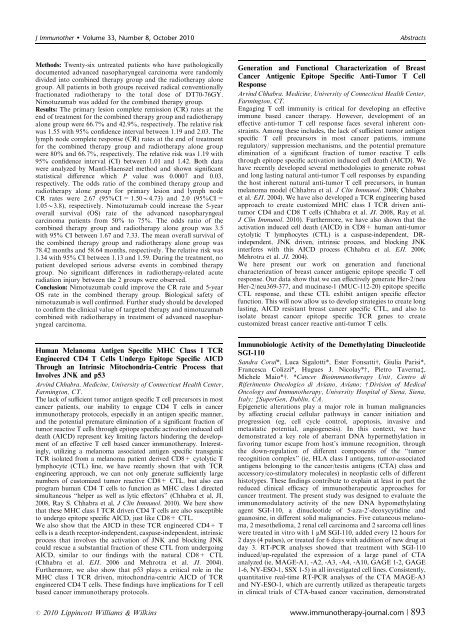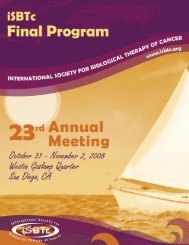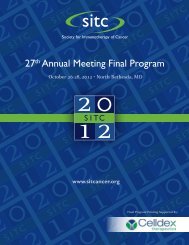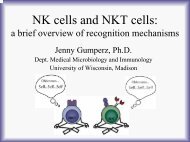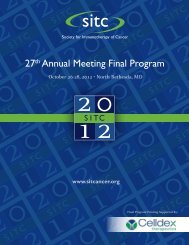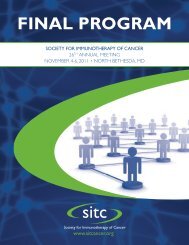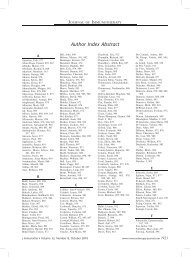Abstracts for the 25th Annual Scientific Meeting of the International ...
Abstracts for the 25th Annual Scientific Meeting of the International ...
Abstracts for the 25th Annual Scientific Meeting of the International ...
Create successful ePaper yourself
Turn your PDF publications into a flip-book with our unique Google optimized e-Paper software.
J Immuno<strong>the</strong>r Volume 33, Number 8, October 2010<br />
<strong>Abstracts</strong><br />
Methods: Twenty-six untreated patients who have pathologically<br />
documented advanced nasopharyngeal carcinoma were randomly<br />
divided into combined <strong>the</strong>rapy group and <strong>the</strong> radio<strong>the</strong>rapy alone<br />
group. All patients in both groups received radical conventionally<br />
fractionated radio<strong>the</strong>rapy to <strong>the</strong> total dose <strong>of</strong> DT70-76GY.<br />
Nimotuzumab was added <strong>for</strong> <strong>the</strong> combined <strong>the</strong>rapy group.<br />
Results: The primary lesion complete remission (CR) rates at <strong>the</strong><br />
end <strong>of</strong> treatment <strong>for</strong> <strong>the</strong> combined <strong>the</strong>rapy group and radio<strong>the</strong>rapy<br />
alone group were 66.7% and 42.9%, respectively. The relative risk<br />
was 1.55 with 95% confidence interval between 1.19 and 2.03. The<br />
lymph node complete response (CR) rates at <strong>the</strong> end <strong>of</strong> treatment<br />
<strong>for</strong> <strong>the</strong> combined <strong>the</strong>rapy group and radio<strong>the</strong>rapy alone group<br />
were 80% and 66.7%, respectively. The relative risk was 1.19 with<br />
95% confidence interval (CI) between 1.01 and 1.42. Both data<br />
were analyzed by Mantl-Haenszel method and shown significant<br />
statistical difference which P value was 0.0007 and 0.03,<br />
respectively. The odds ratio <strong>of</strong> <strong>the</strong> combined <strong>the</strong>rapy group and<br />
radio<strong>the</strong>rapy alone group <strong>for</strong> primary lesion and lymph node<br />
CR rates were 2.67 (95%CI = 1.50B4.73) and 2.0 (95%CI =<br />
1.05B3.8), respectively. Nimotuzumab could increase <strong>the</strong> 5-year<br />
overall survival (OS) rate <strong>of</strong> <strong>the</strong> advanced nasopharyngeal<br />
carcinoma patients from 50% to 75%. The odds ratio <strong>of</strong> <strong>the</strong><br />
combined <strong>the</strong>rapy group and radio<strong>the</strong>rapy alone group was 3.5<br />
with 95% CI between 1.67 and 7.33. The mean overall survival <strong>of</strong><br />
<strong>the</strong> combined <strong>the</strong>rapy group and radio<strong>the</strong>rapy alone group was<br />
78.42 months and 58.64 months, respectively. The relative risk was<br />
1.34 with 95% CI between 1.13 and 1.59. During <strong>the</strong> treatment, no<br />
patient developed serious adverse events in combined <strong>the</strong>rapy<br />
group. No significant differences in radio<strong>the</strong>rapy-related acute<br />
radiation injury between <strong>the</strong> 2 groups were observed.<br />
Conclusion: Nimotuzumab could improve <strong>the</strong> CR rate and 5-year<br />
OS rate in <strong>the</strong> combined <strong>the</strong>rapy group. Biological safety <strong>of</strong><br />
nimotuzumab is well confirmed. Fur<strong>the</strong>r study should be developed<br />
to confirm <strong>the</strong> clinical value <strong>of</strong> targeted <strong>the</strong>rapy and nimotuzumab<br />
combined with radio<strong>the</strong>rapy in treatment <strong>of</strong> advanced nasopharyngeal<br />
carcinoma.<br />
Generation and Functional Characterization <strong>of</strong> Breast<br />
Cancer Antigenic Epitope Specific Anti-Tumor T Cell<br />
Response<br />
Arvind Chhabra. Medicine, University <strong>of</strong> Connecticut Health Center,<br />
Farmington, CT.<br />
Engaging T cell immunity is critical <strong>for</strong> developing an effective<br />
immune based cancer <strong>the</strong>rapy. However, development <strong>of</strong> an<br />
effective anti-tumor T cell response faces several inherent constraints.<br />
Among <strong>the</strong>se includes, <strong>the</strong> lack <strong>of</strong> sufficient tumor antigen<br />
specific T cell precursors in most cancer patients, immune<br />
regulatory/ suppression mechanisms, and <strong>the</strong> potential premature<br />
elimination <strong>of</strong> a significant fraction <strong>of</strong> tumor reactive T cells<br />
through epitope specific activation induced cell death (AICD). We<br />
have recently developed several methodologies to generate robust<br />
and long lasting natural anti-tumor T cell responses by expanding<br />
<strong>the</strong> host inherent natural anti-tumor T cell precursors, in human<br />
melanoma model (Chhabra et al. J Clin Immunol. 2008; Chhabra<br />
et al. EJI. 2004). We have also developed a TCR engineering based<br />
approach to create customized MHC class I TCR driven antitumor<br />
CD4 and CD8 T cells (Chhabra et al. JI. 2008, Ray et al.<br />
J Clin Immunol. 2010). Fur<strong>the</strong>rmore, we have also shown that <strong>the</strong><br />
activation induced cell death (AICD) in CD8+ human anti-tumor<br />
cytolytic T lymphocytes (CTL) is a caspase-independent, DRindependent,<br />
JNK driven, intrinsic process, and blocking JNK<br />
interferes with this AICD process (Chhabra et al. EJI. 2006;<br />
Mehrotra et al. JI. 2004).<br />
We here present our work on generation and functional<br />
characterization <strong>of</strong> breast cancer antigenic epitope specific T cell<br />
response. Our data show that we can effectively generate Her-2/neu<br />
Her-2/neu369-377, and mucinase-1 (MUC-112-20) epitope specific<br />
CTL response, and <strong>the</strong>se CTL exhibit antigen specific effector<br />
function. This will now allow us to develop strategies to create long<br />
lasting, AICD resistant breast cancer specific CTL, and also to<br />
isolate breast cancer epitope specific TCR genes to create<br />
customized breast cancer reactive anti-tumor T cells.<br />
Human Melanoma Antigen Specific MHC Class I TCR<br />
Engineered CD4 T Cells Undergo Epitope Specific AICD<br />
Through an Intrinsic Mitochondria-Centric Process that<br />
Involves JNK and p53<br />
Arvind Chhabra. Medicine, University <strong>of</strong> Connecticut Health Center,<br />
Farmington, CT.<br />
The lack <strong>of</strong> sufficient tumor antigen specific T cell precursors in most<br />
cancer patients, our inability to engage CD4 T cells in cancer<br />
immuno<strong>the</strong>rapy protocols, especially in an antigen specific manner,<br />
and <strong>the</strong> potential premature elimination <strong>of</strong> a significant fraction <strong>of</strong><br />
tumor reactive T cells through epitope specific activation induced cell<br />
death (AICD) represent key limiting factors hindering <strong>the</strong> development<br />
<strong>of</strong> an effective T cell based cancer immuno<strong>the</strong>rapy. Interestingly,<br />
utilizing a melanoma associated antigen specific transgenic<br />
TCR isolated from a melanoma patient derived CD8+ cytolytic T<br />
lymphocyte (CTL) line, we have recently shown that with TCR<br />
engineering approach, we can not only generate sufficiently large<br />
numbers <strong>of</strong> customized tumor reactive CD8+ CTL, but also can<br />
program human CD4 T cells to function as MHC class I directed<br />
simultaneous ‘‘helper as well as lytic effectors’’ (Chhabra et al, JI,<br />
2008, Ray S. Chhabra et al, J Clin Immunol. 2010). We here show<br />
that <strong>the</strong>se MHC class I TCR driven CD4 T cells are also susceptible<br />
to undergo epitope specific AICD, just like CD8+ CTL.<br />
We also show that <strong>the</strong> AICD in <strong>the</strong>se TCR engineered CD4+ T<br />
cells is a death receptor-independent, caspase-independent, intrinsic<br />
process that involves <strong>the</strong> activation <strong>of</strong> JNK and blocking JNK<br />
could rescue a substantial fraction <strong>of</strong> <strong>the</strong>se CTL from undergoing<br />
AICD, similar to our findings with <strong>the</strong> natural CD8+ CTL<br />
(Chhabra et al. EJI. 2006 and Mehrotra et al. JI. 2004).<br />
Fur<strong>the</strong>rmore, we also show that p53 plays a critical role in <strong>the</strong><br />
MHC class I TCR driven, mitochondria-centric AICD <strong>of</strong> TCR<br />
engineered CD4 T cells. These findings have implications <strong>for</strong> T cell<br />
based cancer immuno<strong>the</strong>rapy protocols.<br />
Immunobiologic Activity <strong>of</strong> <strong>the</strong> Demethylating Dinucleotide<br />
SGI-110<br />
Sandra Coral*, Luca Sigalotti*, Ester Fonsattiw, Giulia Parisi*,<br />
Francesca Colizzi*, Hugues J. Nicolay*w, Pietro Tavernaz,<br />
Michele Maio*w. *Cancer Bioimmuno<strong>the</strong>rapy Unit, Centro di<br />
Riferimento Oncologico di Aviano, Aviano; w Division <strong>of</strong> Medical<br />
Oncology and Immuno<strong>the</strong>rapy, University Hospital <strong>of</strong> Siena, Siena,<br />
Italy; zSuperGen, Dublin, CA.<br />
Epigenetic alterations play a major role in human malignancies<br />
by affecting crucial cellular pathways in cancer initiation and<br />
progression (eg, cell cycle control, apoptosis, invasive and<br />
metastatic potential, angiogenesis). In this context, we have<br />
demonstrated a key role <strong>of</strong> aberrant DNA hypermethylation in<br />
favoring tumor escape from host’s immune recognition, through<br />
<strong>the</strong> down-regulation <strong>of</strong> different components <strong>of</strong> <strong>the</strong> ‘‘tumor<br />
recognition complex’’ (ie, HLA class I antigens, tumor-associated<br />
antigens belonging to <strong>the</strong> cancer/testis antigens (CTA) class and<br />
accessory/co-stimulatory molecules) in neoplastic cells <strong>of</strong> different<br />
histotypes. These findings contribute to explain at least in part <strong>the</strong><br />
reduced clinical efficacy <strong>of</strong> immuno<strong>the</strong>rapeutic approaches <strong>for</strong><br />
cancer treatment. The present study was designed to evaluate <strong>the</strong><br />
immunomodulatory activity <strong>of</strong> <strong>the</strong> new DNA hypomethylating<br />
agent SGI-110, a dinucleotide <strong>of</strong> 5-aza-2 0 -deoxycytidine and<br />
guanosine, in different solid malignancies. Five cutaneous melanoma,<br />
2 meso<strong>the</strong>lioma, 2 renal cell carcinoma and 2 sarcoma cell lines<br />
were treated in vitro with 1 mM SGI-110, added every 12 hours <strong>for</strong><br />
2 days (4 pulses), or treated <strong>for</strong> 6 days with addition <strong>of</strong> new drug at<br />
day 3. RT-PCR analyses showed that treatment with SGI-110<br />
induced/up-regulated <strong>the</strong> expression <strong>of</strong> a large panel <strong>of</strong> CTA<br />
analyzed (ie, MAGE-A1, -A2, -A3, -A4, -A10, GAGE 1-2, GAGE<br />
1-6, NY-ESO-1, SSX 1-5) in all investigated cell lines. Consistently,<br />
quantitative real-time RT-PCR analyses <strong>of</strong> <strong>the</strong> CTA MAGE-A3<br />
and NY-ESO-1, which are currently utilized as <strong>the</strong>rapeutic targets<br />
in clinical trials <strong>of</strong> CTA-based cancer vaccination, demonstrated<br />
r 2010 Lippincott Williams & Wilkins www.immuno<strong>the</strong>rapy-journal.com | 893


